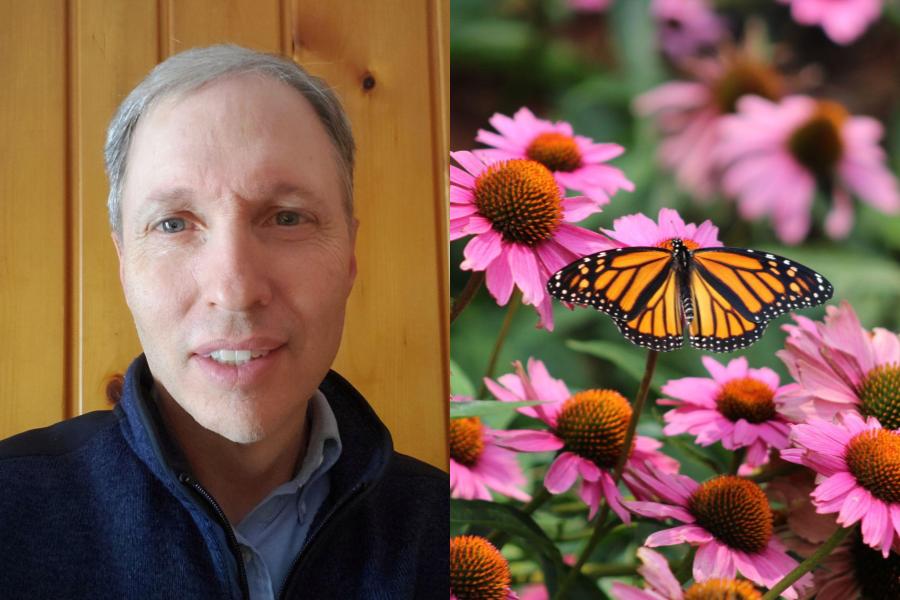
MINNEAPOLIS/ST. PAUL (04/13/2023) — Minnesotans are eager to get back to their gardens and are busy picking out this year’s plants and seeds. As you make your garden selections this spring, consider plants that will help support the state’s declining pollinator populations.
Dan Shaw, an adjunct assistant professor in the College of Design, answers questions about how you can create your own residential pollinator garden to support these critical species and their vital role in maintaining healthy ecosystems.
Q: What are pollinator gardens and why are they important?
Shaw: Minnesota is home to around 500 native bee species, as well as other pollinators including butterflies, moths, beetles and hummingbirds. Unfortunately, the populations of many species are in decline. Pollinator gardens are plantings designed to support a wide range of species by providing sources of pollen and nectar, as well as nesting sites. A diversity of flowers, grasses and native shrubs are used in pollinator gardens to provide flower resources throughout spring, summer and fall.
Q: What plants would you recommend for beginners?
Shaw: It is best to start with plants that are easy to care for but also provide rich sources of nectar and pollen. Some good options include common yarrow, whorled milkweed, purple prairie clover, giant hyssop, rough blazingstar, wild bergamot, narrow-leaved coneflower, showy goldenrod, smooth aster and golden alexanders. Lower-growing native grasses that provide structural support for flowers and enhance nesting habitat for bees include little bluestem grass and sideoats grama. Pollinator beneficial shrubs include black chokeberry, redtwig dogwood and ninebark. It is helpful to find native plant nurseries in your areas as their staff can help answer your plant selection questions. Starting with small projects is beneficial for new gardeners as plantings can be expanded over time.
Q: I want to avoid a messy-looking yard, do you have any design suggestions?
Shaw: A messy appearance usually results from having a random arrangement of plants with different plant heights. As a result, we recommend grouping 5-7 plants of the same species together and placing small plants in front and tall plants in the back of plantings. Groupings of plants also make pollination more efficient for bees and butterflies. The human eye is drawn to lines in the landscape, so the use of garden edging can also create a sense of order. Walkways, fences and walls along plantings also add to the aesthetics of plantings. We typically recommend native plants for pollinator gardens as these species have evolved along with our native insects but traditional garden perennials that form attractive clumps such as hostas, coral bells, sedums and salvia can also be incorporated into plantings.
Q: Can I build a pollinator garden if I don’t own a home or have a yard?
Shaw: Yes, planters can also support pollinator populations. Research has shown that even small gardens provide many benefits, particularly when the plants are well cared for, resulting in rich sources of pollen and nectar. If many neighborhood residents are establishing a habitat, a larger matrix of plantings can be created, supporting a wide range of bee species. Smaller, drought-tolerant species can work well in planters including prairie smoke, wild columbine, hoary vervain, lance-leaf coreopsis, prairie spiderwort and prairie dropseed grass.
Q: What programs are available to help Minnesotans create pollinator gardens?
Shaw: Lawns to Legumes is a program funded by Minnesota’s Environment and Natural Resources Trust Fund that provides $350 grants for residential pollinator gardens along with habitat guides, planting templates and coaching. The program has assisted over 3,000 residents in Minnesota since 2019. Anyone interested in the program can visit the Lawns to Legumes application page. The current application period is open through July 15. It can also be helpful to check with County Soil and Water Conservation Districts or Environmental Services Departments to see if they can direct you to other funding sources.
Dan Shaw is an adjunct assistant professor in the College of Design, a senior ecologist for the Minnesota Board of Water and Soil Resources and a program coordinator for the Lawns to Legumes project.
About the College of Design
Located in a major design city and in one of the largest research universities in the U.S., the University of Minnesota's College of Design encompasses a full range of design disciplines—including landscape architecture, architecture, retail merchandising, and the design of interiors, graphics, apparel, and other products. Faculty, students, and staff aim to advance the quality of manufactured objects and our natural, built, and social environments through sustainably resilient, socially responsible, civically engaged, and human-centered design collaborations.
About “Talking...with U of M”
“Talking...with U of M” is a resource whereby University of Minnesota faculty answer questions on current and other topics of general interest. Feel free to republish this content. If you would like to schedule an interview with the faculty member or have topics you’d like the University of Minnesota to explore for future “Talking...with U of M,” please contact University Public Relations at [email protected].
- Categories:
- Architecture and Design
- Environmental health





